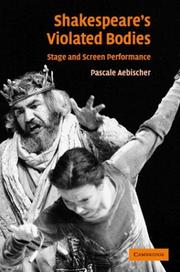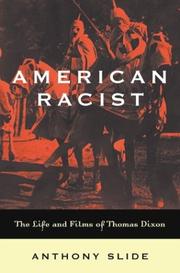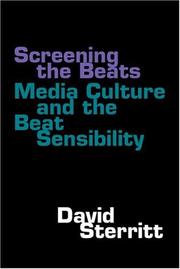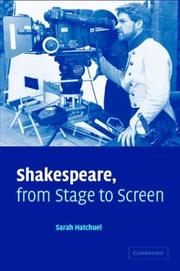| Listing 1 - 10 of 12 | << page >> |
Sort by
|
Book
ISBN: 225203453X 9782252034538 Year: 2004 Publisher: Paris: Klincksieck,
Abstract | Keywords | Export | Availability | Bookmark
 Loading...
Loading...Choose an application
- Reference Manager
- EndNote
- RefWorks (Direct export to RefWorks)
Considérant que l'adaptation cinématographique n'est pas le sous-produit d'un roman mais une nouvelle œuvre à part entière, ce livre souhaite envisager trois problématiques complémentaires : Analysant le parcours historique de l'adaptation en France, on constate que de grands écrivains n'ont pas dédaigné la mise en forme scénaristique et parfois le tournage de leurs propres œuvres, ce qui les a conduits à prendre conscience de la véritable opération de réécriture que leur imposait la mise en images. On envisage ensuite le parcours inverse : la réécriture littéraire des films. Le roman-cinéma des années 1920, le ciné-roman de Robbe-Grillet et les " novélisations " actuelles, en voulant restituer par les mots l'effet de présence de l'image, posent la question de la réalité et de l'illusion. Enfin, à travers l'analyse des relations entre Alain Resnais et ses scénaristes-écrivains, on montre comment cette collaboration tend à l'indifférenciation des deux genres, littéraire et cinématographique. Indifférenciation qui aboutit aujourd'hui, dans la littérature, à des écritures qu'on peut qualifier de " transmodales ".
Film adaptations. --- Cinéma et littérature --- Adaptation cinématographiques --- Histoire et critique

Abstract | Keywords | Export | Availability | Bookmark
 Loading...
Loading...Choose an application
- Reference Manager
- EndNote
- RefWorks (Direct export to RefWorks)
Women in motion pictures --- Film adaptations --- England in motion pictures
Book
Year: 2004 Publisher: Johns Hopkins University Press
Abstract | Keywords | Export | Availability | Bookmark
 Loading...
Loading...Choose an application
- Reference Manager
- EndNote
- RefWorks (Direct export to RefWorks)
William Faulkner occupied a unique position as a modern writer. Although famous for his modernist novels and their notorious difficulty, he also wrote extensively for the "culture industry," and the works he produced for it—including short stories, adaptations, and screenplays—bore many of the hallmarks of consumer art. His experiences as a Hollywood screenwriter influenced him in a number of ways, many of them negative, while the films turned out by the "dream factories" in which he labored sporadically inspired both his interest and his contempt. Faulkner also disparaged the popular magazines—though he frequently sold short stories to them.To what extent was Faulkner's deeply ambivalent relationship to—and involvement with—American popular culture reflected in his modernist or "art" fiction? Peter Lurie finds convincing evidence that Faulkner was keenly aware of commercial culture and adapted its formulae, strategies, and in particular, its visual techniques into the language of his novels of the 1930s. Lurie contends that Faulkner's modernism can be best understood in light of his reaction to the popular culture of his day. Using Theodor Adorno's theory about modern cultural production as a framework, Lurie's close readings of Sanctuary, Light in August, Absalom! Absalom!, and If I Forget Thee, Jerusalem uncover the cultural history that surrounded and influenced the development of Faulkner's art. Lurie is particularly interested in the influence of cinema on Faulkner's fiction and especially the visual strategies he both deployed and critiqued. These include the suggestion of cinematic viewing on the part of readers and of characters in each of the novels; the collective and individual acts of voyeurism in Sanctuary and Light in August; the exposing in Absalom! Absalom! and Light in Augustof stereotypical and cinematic patterns of thought about history and race; and the evocation of popular forms like melodrama and the movie screen in If I Forget Thee, Jerusalem. Offering innovative readings of these canonical works, this study sheds new light on Faulkner's uniquely American modernism.
Film adaptations. --- American fiction --- Motion pictures --- Popular culture --- Literary theory --- History --- History --- Faulkner, William, --- Film and video adaptations.
Book
Year: 2004 Publisher: Johns Hopkins University Press
Abstract | Keywords | Export | Availability | Bookmark
 Loading...
Loading...Choose an application
- Reference Manager
- EndNote
- RefWorks (Direct export to RefWorks)
William Faulkner occupied a unique position as a modern writer. Although famous for his modernist novels and their notorious difficulty, he also wrote extensively for the "culture industry," and the works he produced for it—including short stories, adaptations, and screenplays—bore many of the hallmarks of consumer art. His experiences as a Hollywood screenwriter influenced him in a number of ways, many of them negative, while the films turned out by the "dream factories" in which he labored sporadically inspired both his interest and his contempt. Faulkner also disparaged the popular magazines—though he frequently sold short stories to them.To what extent was Faulkner's deeply ambivalent relationship to—and involvement with—American popular culture reflected in his modernist or "art" fiction? Peter Lurie finds convincing evidence that Faulkner was keenly aware of commercial culture and adapted its formulae, strategies, and in particular, its visual techniques into the language of his novels of the 1930s. Lurie contends that Faulkner's modernism can be best understood in light of his reaction to the popular culture of his day. Using Theodor Adorno's theory about modern cultural production as a framework, Lurie's close readings of Sanctuary, Light in August, Absalom! Absalom!, and If I Forget Thee, Jerusalem uncover the cultural history that surrounded and influenced the development of Faulkner's art. Lurie is particularly interested in the influence of cinema on Faulkner's fiction and especially the visual strategies he both deployed and critiqued. These include the suggestion of cinematic viewing on the part of readers and of characters in each of the novels; the collective and individual acts of voyeurism in Sanctuary and Light in August; the exposing in Absalom! Absalom! and Light in Augustof stereotypical and cinematic patterns of thought about history and race; and the evocation of popular forms like melodrama and the movie screen in If I Forget Thee, Jerusalem. Offering innovative readings of these canonical works, this study sheds new light on Faulkner's uniquely American modernism.
Film adaptations. --- American fiction --- Motion pictures --- Popular culture --- History --- History --- Faulkner, William, --- Film and video adaptations. --- Literary theory
Book
Year: 2004 Publisher: Johns Hopkins University Press
Abstract | Keywords | Export | Availability | Bookmark
 Loading...
Loading...Choose an application
- Reference Manager
- EndNote
- RefWorks (Direct export to RefWorks)
William Faulkner occupied a unique position as a modern writer. Although famous for his modernist novels and their notorious difficulty, he also wrote extensively for the "culture industry," and the works he produced for it—including short stories, adaptations, and screenplays—bore many of the hallmarks of consumer art. His experiences as a Hollywood screenwriter influenced him in a number of ways, many of them negative, while the films turned out by the "dream factories" in which he labored sporadically inspired both his interest and his contempt. Faulkner also disparaged the popular magazines—though he frequently sold short stories to them.To what extent was Faulkner's deeply ambivalent relationship to—and involvement with—American popular culture reflected in his modernist or "art" fiction? Peter Lurie finds convincing evidence that Faulkner was keenly aware of commercial culture and adapted its formulae, strategies, and in particular, its visual techniques into the language of his novels of the 1930s. Lurie contends that Faulkner's modernism can be best understood in light of his reaction to the popular culture of his day. Using Theodor Adorno's theory about modern cultural production as a framework, Lurie's close readings of Sanctuary, Light in August, Absalom! Absalom!, and If I Forget Thee, Jerusalem uncover the cultural history that surrounded and influenced the development of Faulkner's art. Lurie is particularly interested in the influence of cinema on Faulkner's fiction and especially the visual strategies he both deployed and critiqued. These include the suggestion of cinematic viewing on the part of readers and of characters in each of the novels; the collective and individual acts of voyeurism in Sanctuary and Light in August; the exposing in Absalom! Absalom! and Light in Augustof stereotypical and cinematic patterns of thought about history and race; and the evocation of popular forms like melodrama and the movie screen in If I Forget Thee, Jerusalem. Offering innovative readings of these canonical works, this study sheds new light on Faulkner's uniquely American modernism.
Film adaptations. --- American fiction --- Motion pictures --- Popular culture --- History --- History --- Faulkner, William, --- Film and video adaptations. --- Literary theory

ISBN: 0521829356 Year: 2004 Publisher: Cambridge : Cambridge university press,
Abstract | Keywords | Export | Availability | Bookmark
 Loading...
Loading...Choose an application
- Reference Manager
- EndNote
- RefWorks (Direct export to RefWorks)

ISBN: 0813138248 1283232944 9786613232946 0813171911 9780813171913 9780813138244 0813123283 9780813123288 Year: 2004 Publisher: Lexington : University Press of Kentucky,
Abstract | Keywords | Export | Availability | Bookmark
 Loading...
Loading...Choose an application
- Reference Manager
- EndNote
- RefWorks (Direct export to RefWorks)
"" Thomas Dixon has a notorious reputation as the writer of the source material for D.W. Griffith's groundbreaking and controversial 1915 feature film The Birth of a Nation. Perhaps unfairly, Dixon has been branded an arch-conservative and a racist obsessed with what he viewed as ""the Negro problem."" As American Racist makes clear, however, Dixon was a complex, multi-talented individual who, as well as writing some of the most popular novels of the early twentieth century, was involved in the production of some eighteen films. Dixon used the motion picture as a propaganda tool for his
Racism in literature. --- Racism --- Racism in motion pictures. --- African Americans in literature. --- African Americans in motion pictures. --- Film adaptations --- Authors, American --- Motion pictures --- Afro-Americans in literature --- Negroes in literature --- Afro-Americans in motion pictures --- Negroes in moving-pictures --- Race films --- History and criticism. --- History --- Dixon, Thomas, --- Dixon, Thomas F., --- Political and social views. --- Film and video adaptations.

ISBN: 1429417803 9781429417808 0809325632 9780809325634 Year: 2004 Publisher: Carbondale : Southern Illinois University Press,
Abstract | Keywords | Export | Availability | Bookmark
 Loading...
Loading...Choose an application
- Reference Manager
- EndNote
- RefWorks (Direct export to RefWorks)
Beat literature --- Mass media and literature --- Mass media --- American Literature --- English --- Languages & Literatures --- Mass communication --- Media, Mass --- Media, The --- Communication --- Literature and mass media --- Literature --- History and criticism. --- History --- Film adaptations. --- Kerouac, Jack, --- Kerouac, Jack --- Kerouac, John --- Kérouac, Jean Louis Lebris de --- Chia-lo-kʻo, Chieh-kʻo --- Keruak, Dz︠h︡ek --- Ḳeruʼaḳ, G'eḳ --- קרואק, ג׳ק,

ISBN: 063123053X 9780631230533 9781405177559 Year: 2004 Volume: 7
Abstract | Keywords | Export | Availability | Bookmark
 Loading...
Loading...Choose an application
- Reference Manager
- EndNote
- RefWorks (Direct export to RefWorks)
Film --- Literature --- Literature and motion pictures --- Literatuur en film --- Littérature et cinéma --- Motion pictures and literature. --- Film adaptations --- Television adaptations --- History and criticism. --- 82:791.43 --- 82:791.43 Literatuur en film --- Cinéma et littérature --- Cinéma et poésie --- Cinéma et roman --- Film en literatuur --- Literature and moving pictures --- Literature and moving-pictures --- Motion pictures and literature --- Moving pictures and literature --- Moving-pictures and literature --- Poésie et cinéma --- Roman et cinéma --- History and criticism --- Adaptations cinématographiques --- Histoire et critique

ISBN: 0521836247 0521078989 1107150027 0511214839 0511216629 0511315406 0511483619 1280540311 0511211252 0511213026 9780521836241 9780521078986 9780511211256 9780511213021 9780511214837 9780511216626 9780511483615 9781280540318 9781107150027 9780511315404 Year: 2004 Publisher: Cambridge : Cambridge University Press,
Abstract | Keywords | Export | Availability | Bookmark
 Loading...
Loading...Choose an application
- Reference Manager
- EndNote
- RefWorks (Direct export to RefWorks)
How is a Shakespearean play transformed when it is directed for the screen? In this 2004 book, Sarah Hatchuel uses literary criticism, narratology, performance history, psychoanalysis and semiotics to analyse how the plays are fundamentally altered in their screen versions. She identifies distinct strategies chosen by film directors to appropriate the plays. Instead of providing just play-by-play or film-by-film analyses, the book addresses the main issues of theatre/film aesthetics, making such theories and concepts accessible before applying them to practical cases. Her book also offers guidelines for the study of sequences in Shakespearean adaptations and includes examples from all the major films from the 1899 King John, through the adaptations by Olivier, Welles and Branagh, to Taymor's 2000 Titus and beyond. This book is aimed at scholars, teachers and students of Shakespeare and film studies, providing a clear and logical apparatus with which to examine Shakespearean screen adaptations.
English drama --- Film adaptations --- Film and video adaptations --- History and criticism --- Shakespeare, William, --- History and criticism. --- Arts and Humanities --- Literature --- Shakespeare, William --- Shakespear, William, --- Shakspeare, William, --- Šekʻspiri, Uiliam, --- Saixpēr, Gouilliam, --- Shakspere, William, --- Shikisbīr, Wilyam, --- Szekspir, Wiliam, --- Šekspyras, --- Shekspir, Vilʹi︠a︡m, --- Šekspir, Viljem, --- Tsikinya-chaka, --- Sha-shih-pi-ya, --- Shashibiya, --- Sheḳspir, Ṿilyam, --- Shaḳspir, Ṿilyam, --- Syeiksŭpʻio, --- Shekspir, V. --- Szekspir, William, --- Shakespeare, Guglielmo, --- Shake-speare, William, --- Sha-ō, --- Şekspir, --- Shekspir, Uiliam, --- Shekspir, U. --- Šekspir, Vilijam, --- Ṣēkspiyar, Viliyam, --- Shakspir, --- Shekspyr, Vyli︠e︡m, --- Şekspir, Velyam, --- Ṣēkspiyar, Villiyam, --- Shēkʻspʻiyr, Vlilliam, --- Ṣēkspiyar, --- Ṣēkspiyar Mahākavi, --- Ṣēkspiyar Mahākaviya, --- Sheḳspier, Ṿilyam, --- Shēkʻspir, --- Shakespeare, --- Śeksper, --- Шекспир, Вильям, --- Шекспир, Уильям, --- שייקספיר, וויליאם, --- שייקספיר, וו., --- שיקספיר, וויליאם --- שיקספיר, ויליאם --- שיקספיר, ויליאם, --- שכספיר, ויליאם, --- שכספיר, וילים, --- שכספיר, ו׳ --- שעפקספיר, וויליאם, --- שעקספיער, וויליאם --- שעקספיער, וויליאם, --- שעקספיער, ווילליאם --- שעקספיער, וו., --- שעקספיר --- שעקספיר, וו --- שעקספיר, וויליאם, --- שעקספיר, וויליאמ --- שעקספיר, ווילליאם --- שעקספיר, ווילליאם, --- שעקספיר, וו., --- שעקספיר, װיליאם, --- שעקספיר, װילליאם, --- שעקספיר, װ., --- שעקספער --- שעקספער, וויליאמ --- שקספיר --- שקספיר, וו --- שקספיר, וויליאם --- שקספיר, וויליאם, --- שקספיר, ווילים, --- שקספיר, וילאם --- שקספיר, ויליאם --- שקספיר, ויליאם, --- שקספיר, ויליים, --- שקספיר, וילים --- שקספיר, וילים, --- شاكسبير، وليم --- شاكسپير، وليم --- شكسبير، وليام --- شكسبير، وليم --- شكسبير، وليم، --- شكسبير، و. --- شكسپير، وليم --- شكسپير، ويليام --- شيكسبير، وليام --- شيكسبير، وليام.، --- شيكسبير، وليم --- شکسبير، وليم --- وليم شکسبير --- 沙士北亞威廉姆, --- 沙士比亞威廉姆, --- 莎士比亞威廉姆, --- 莎士比亞威廉, --- 莎士比亞, --- English drama - Film and video adaptations --- Film adaptations - History and criticism --- Shakespeare, William, - 1564-1616 - Film and video adaptations --- Shakespeare, William, - 1564-1616 --- Film adaptations.
| Listing 1 - 10 of 12 | << page >> |
Sort by
|

 Search
Search Feedback
Feedback About
About Help
Help News
News